ACC621 Audit Report: Analysis of Ateneo Enterprise Financials
VerifiedAdded on 2023/06/07
|12
|2165
|361
Report
AI Summary
This report provides an in-depth analysis of an audit conducted on Ateneo Enterprise, examining various aspects of the financial statements. The report begins with an introduction discussing auditing standards and their implications, followed by an analysis of the trial balance. It assesses materiality levels based on the partner's suggestion and auditing standards, conducts a trend analysis to identify potential misstatements, and pinpoints income statement accounts at risk. The report then outlines necessary audit procedures to address the identified risks, emphasizing existence, occurrence, rights, obligations, valuation, and sampling. It also addresses the partner's perspective on fraud risk, referencing relevant auditing standards. The report concludes with a summary of key findings and insights, referencing relevant research papers.

Running head: AUDIT
Audit
Name of the Student:
Name of the University:
Authors Note:
Audit
Name of the Student:
Name of the University:
Authors Note:
Paraphrase This Document
Need a fresh take? Get an instant paraphrase of this document with our AI Paraphraser
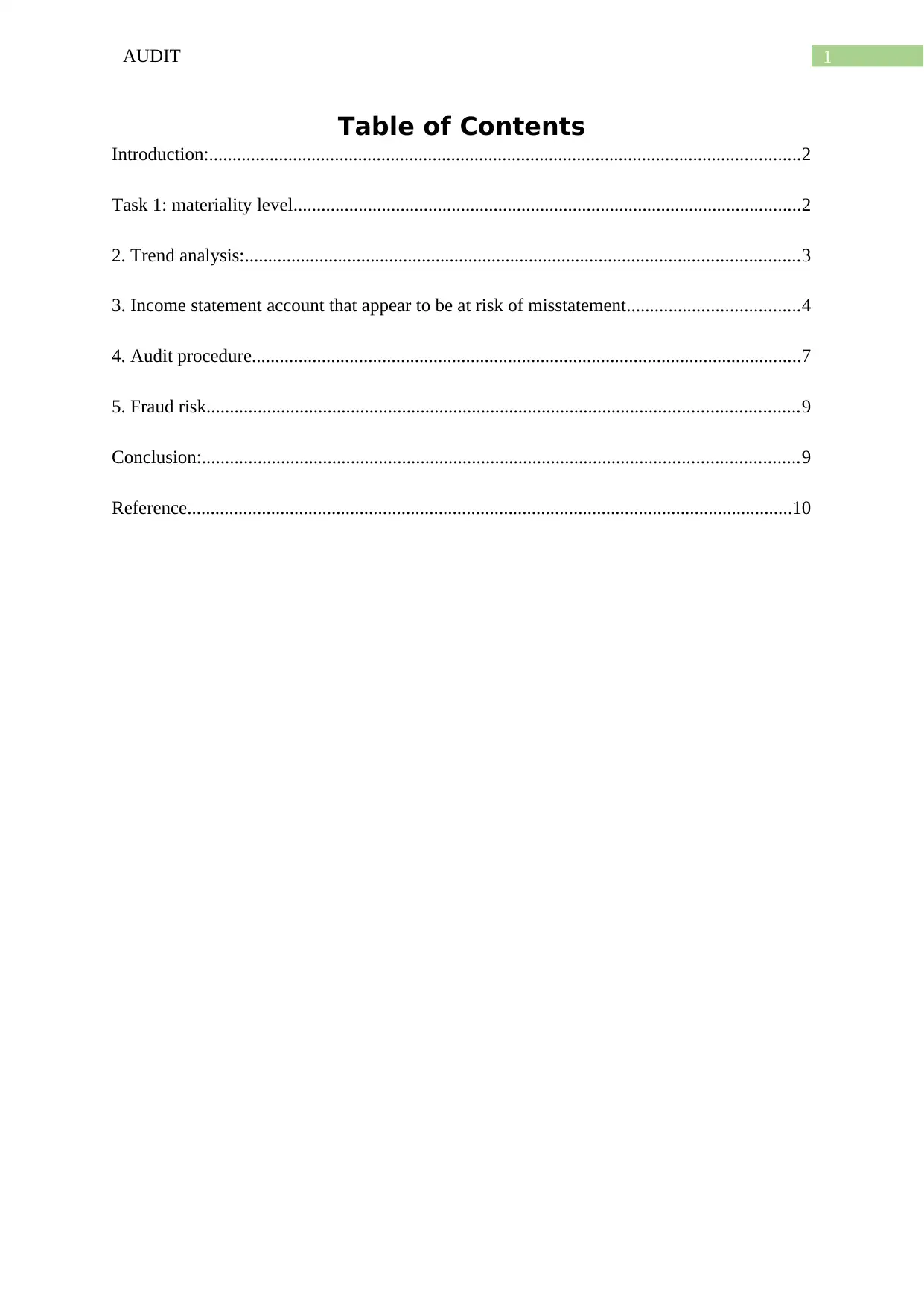
1AUDIT
Table of Contents
Introduction:...............................................................................................................................2
Task 1: materiality level.............................................................................................................2
2. Trend analysis:.......................................................................................................................3
3. Income statement account that appear to be at risk of misstatement.....................................4
4. Audit procedure......................................................................................................................7
5. Fraud risk...............................................................................................................................9
Conclusion:................................................................................................................................9
Reference..................................................................................................................................10
Table of Contents
Introduction:...............................................................................................................................2
Task 1: materiality level.............................................................................................................2
2. Trend analysis:.......................................................................................................................3
3. Income statement account that appear to be at risk of misstatement.....................................4
4. Audit procedure......................................................................................................................7
5. Fraud risk...............................................................................................................................9
Conclusion:................................................................................................................................9
Reference..................................................................................................................................10
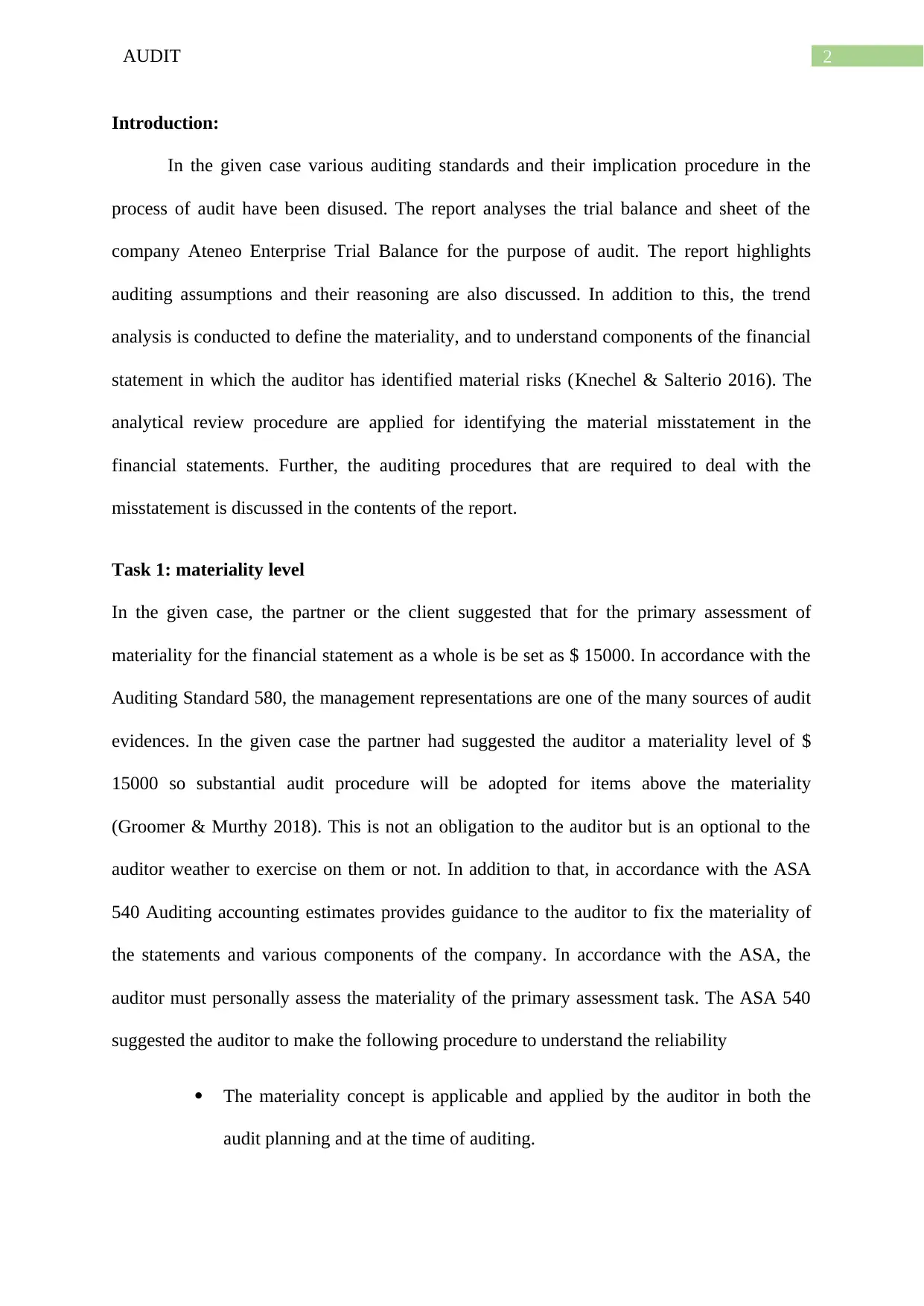
2AUDIT
Introduction:
In the given case various auditing standards and their implication procedure in the
process of audit have been disused. The report analyses the trial balance and sheet of the
company Ateneo Enterprise Trial Balance for the purpose of audit. The report highlights
auditing assumptions and their reasoning are also discussed. In addition to this, the trend
analysis is conducted to define the materiality, and to understand components of the financial
statement in which the auditor has identified material risks (Knechel & Salterio 2016). The
analytical review procedure are applied for identifying the material misstatement in the
financial statements. Further, the auditing procedures that are required to deal with the
misstatement is discussed in the contents of the report.
Task 1: materiality level
In the given case, the partner or the client suggested that for the primary assessment of
materiality for the financial statement as a whole is be set as $ 15000. In accordance with the
Auditing Standard 580, the management representations are one of the many sources of audit
evidences. In the given case the partner had suggested the auditor a materiality level of $
15000 so substantial audit procedure will be adopted for items above the materiality
(Groomer & Murthy 2018). This is not an obligation to the auditor but is an optional to the
auditor weather to exercise on them or not. In addition to that, in accordance with the ASA
540 Auditing accounting estimates provides guidance to the auditor to fix the materiality of
the statements and various components of the company. In accordance with the ASA, the
auditor must personally assess the materiality of the primary assessment task. The ASA 540
suggested the auditor to make the following procedure to understand the reliability
The materiality concept is applicable and applied by the auditor in both the
audit planning and at the time of auditing.
Introduction:
In the given case various auditing standards and their implication procedure in the
process of audit have been disused. The report analyses the trial balance and sheet of the
company Ateneo Enterprise Trial Balance for the purpose of audit. The report highlights
auditing assumptions and their reasoning are also discussed. In addition to this, the trend
analysis is conducted to define the materiality, and to understand components of the financial
statement in which the auditor has identified material risks (Knechel & Salterio 2016). The
analytical review procedure are applied for identifying the material misstatement in the
financial statements. Further, the auditing procedures that are required to deal with the
misstatement is discussed in the contents of the report.
Task 1: materiality level
In the given case, the partner or the client suggested that for the primary assessment of
materiality for the financial statement as a whole is be set as $ 15000. In accordance with the
Auditing Standard 580, the management representations are one of the many sources of audit
evidences. In the given case the partner had suggested the auditor a materiality level of $
15000 so substantial audit procedure will be adopted for items above the materiality
(Groomer & Murthy 2018). This is not an obligation to the auditor but is an optional to the
auditor weather to exercise on them or not. In addition to that, in accordance with the ASA
540 Auditing accounting estimates provides guidance to the auditor to fix the materiality of
the statements and various components of the company. In accordance with the ASA, the
auditor must personally assess the materiality of the primary assessment task. The ASA 540
suggested the auditor to make the following procedure to understand the reliability
The materiality concept is applicable and applied by the auditor in both the
audit planning and at the time of auditing.
⊘ This is a preview!⊘
Do you want full access?
Subscribe today to unlock all pages.

Trusted by 1+ million students worldwide
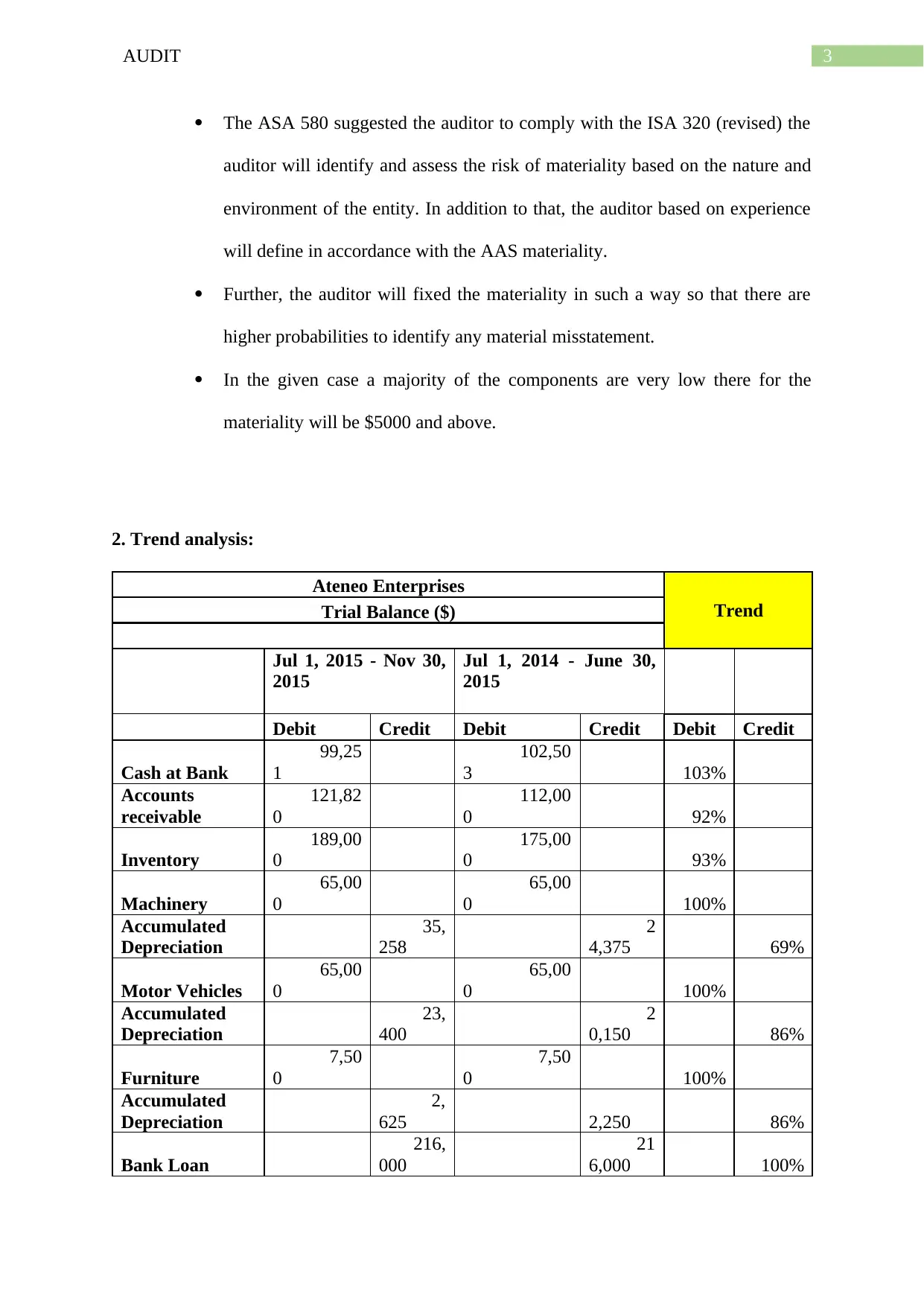
3AUDIT
The ASA 580 suggested the auditor to comply with the ISA 320 (revised) the
auditor will identify and assess the risk of materiality based on the nature and
environment of the entity. In addition to that, the auditor based on experience
will define in accordance with the AAS materiality.
Further, the auditor will fixed the materiality in such a way so that there are
higher probabilities to identify any material misstatement.
In the given case a majority of the components are very low there for the
materiality will be $5000 and above.
2. Trend analysis:
Ateneo Enterprises
TrendTrial Balance ($)
Jul 1, 2015 - Nov 30,
2015
Jul 1, 2014 - June 30,
2015
Debit Credit Debit Credit Debit Credit
Cash at Bank
99,25
1
102,50
3 103%
Accounts
receivable
121,82
0
112,00
0 92%
Inventory
189,00
0
175,00
0 93%
Machinery
65,00
0
65,00
0 100%
Accumulated
Depreciation
35,
258
2
4,375 69%
Motor Vehicles
65,00
0
65,00
0 100%
Accumulated
Depreciation
23,
400
2
0,150 86%
Furniture
7,50
0
7,50
0 100%
Accumulated
Depreciation
2,
625 2,250 86%
Bank Loan
216,
000
21
6,000 100%
The ASA 580 suggested the auditor to comply with the ISA 320 (revised) the
auditor will identify and assess the risk of materiality based on the nature and
environment of the entity. In addition to that, the auditor based on experience
will define in accordance with the AAS materiality.
Further, the auditor will fixed the materiality in such a way so that there are
higher probabilities to identify any material misstatement.
In the given case a majority of the components are very low there for the
materiality will be $5000 and above.
2. Trend analysis:
Ateneo Enterprises
TrendTrial Balance ($)
Jul 1, 2015 - Nov 30,
2015
Jul 1, 2014 - June 30,
2015
Debit Credit Debit Credit Debit Credit
Cash at Bank
99,25
1
102,50
3 103%
Accounts
receivable
121,82
0
112,00
0 92%
Inventory
189,00
0
175,00
0 93%
Machinery
65,00
0
65,00
0 100%
Accumulated
Depreciation
35,
258
2
4,375 69%
Motor Vehicles
65,00
0
65,00
0 100%
Accumulated
Depreciation
23,
400
2
0,150 86%
Furniture
7,50
0
7,50
0 100%
Accumulated
Depreciation
2,
625 2,250 86%
Bank Loan
216,
000
21
6,000 100%
Paraphrase This Document
Need a fresh take? Get an instant paraphrase of this document with our AI Paraphraser
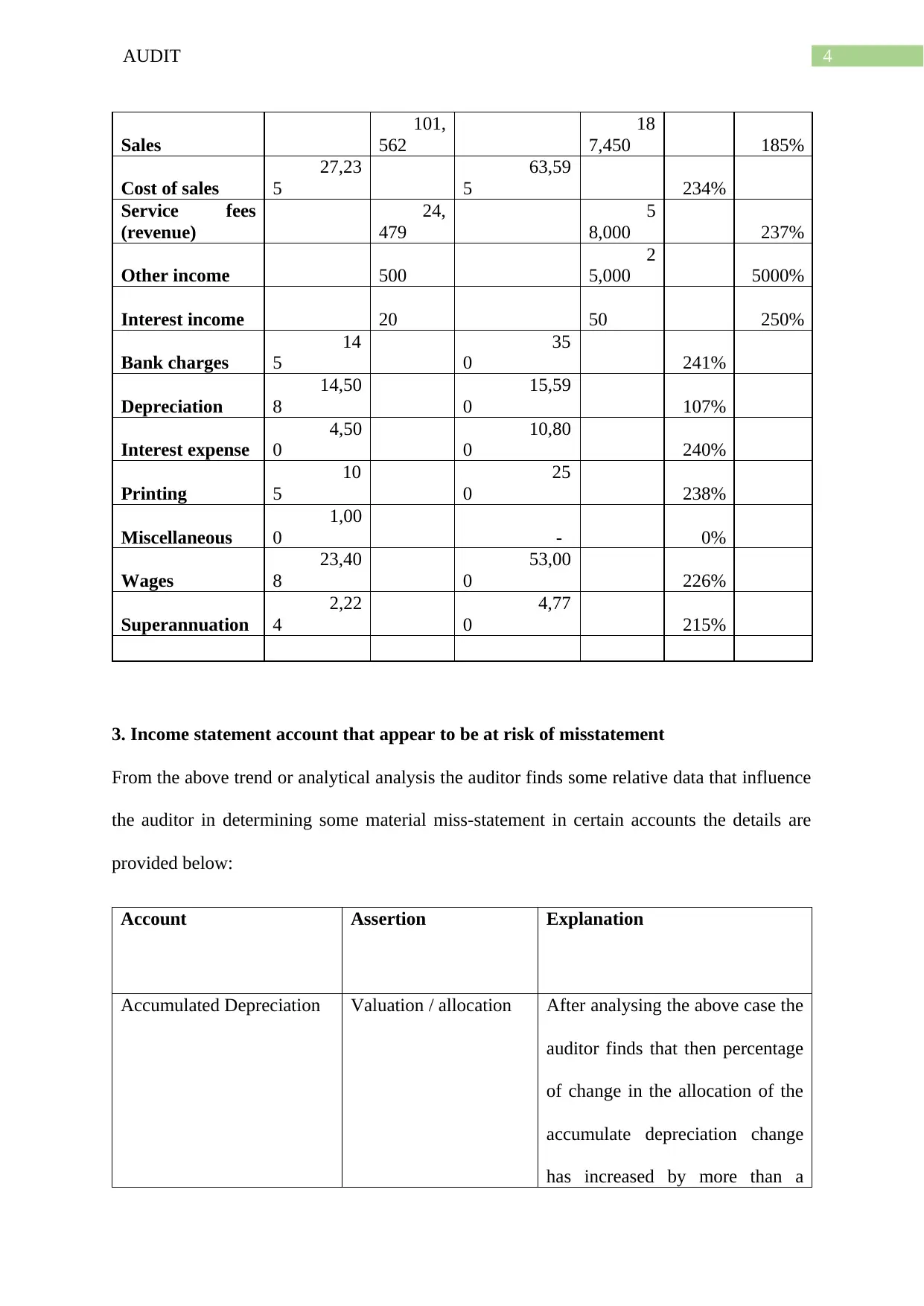
4AUDIT
Sales
101,
562
18
7,450 185%
Cost of sales
27,23
5
63,59
5 234%
Service fees
(revenue)
24,
479
5
8,000 237%
Other income 500
2
5,000 5000%
Interest income 20 50 250%
Bank charges
14
5
35
0 241%
Depreciation
14,50
8
15,59
0 107%
Interest expense
4,50
0
10,80
0 240%
Printing
10
5
25
0 238%
Miscellaneous
1,00
0 - 0%
Wages
23,40
8
53,00
0 226%
Superannuation
2,22
4
4,77
0 215%
3. Income statement account that appear to be at risk of misstatement
From the above trend or analytical analysis the auditor finds some relative data that influence
the auditor in determining some material miss-statement in certain accounts the details are
provided below:
Account Assertion Explanation
Accumulated Depreciation Valuation / allocation After analysing the above case the
auditor finds that then percentage
of change in the allocation of the
accumulate depreciation change
has increased by more than a
Sales
101,
562
18
7,450 185%
Cost of sales
27,23
5
63,59
5 234%
Service fees
(revenue)
24,
479
5
8,000 237%
Other income 500
2
5,000 5000%
Interest income 20 50 250%
Bank charges
14
5
35
0 241%
Depreciation
14,50
8
15,59
0 107%
Interest expense
4,50
0
10,80
0 240%
Printing
10
5
25
0 238%
Miscellaneous
1,00
0 - 0%
Wages
23,40
8
53,00
0 226%
Superannuation
2,22
4
4,77
0 215%
3. Income statement account that appear to be at risk of misstatement
From the above trend or analytical analysis the auditor finds some relative data that influence
the auditor in determining some material miss-statement in certain accounts the details are
provided below:
Account Assertion Explanation
Accumulated Depreciation Valuation / allocation After analysing the above case the
auditor finds that then percentage
of change in the allocation of the
accumulate depreciation change
has increased by more than a
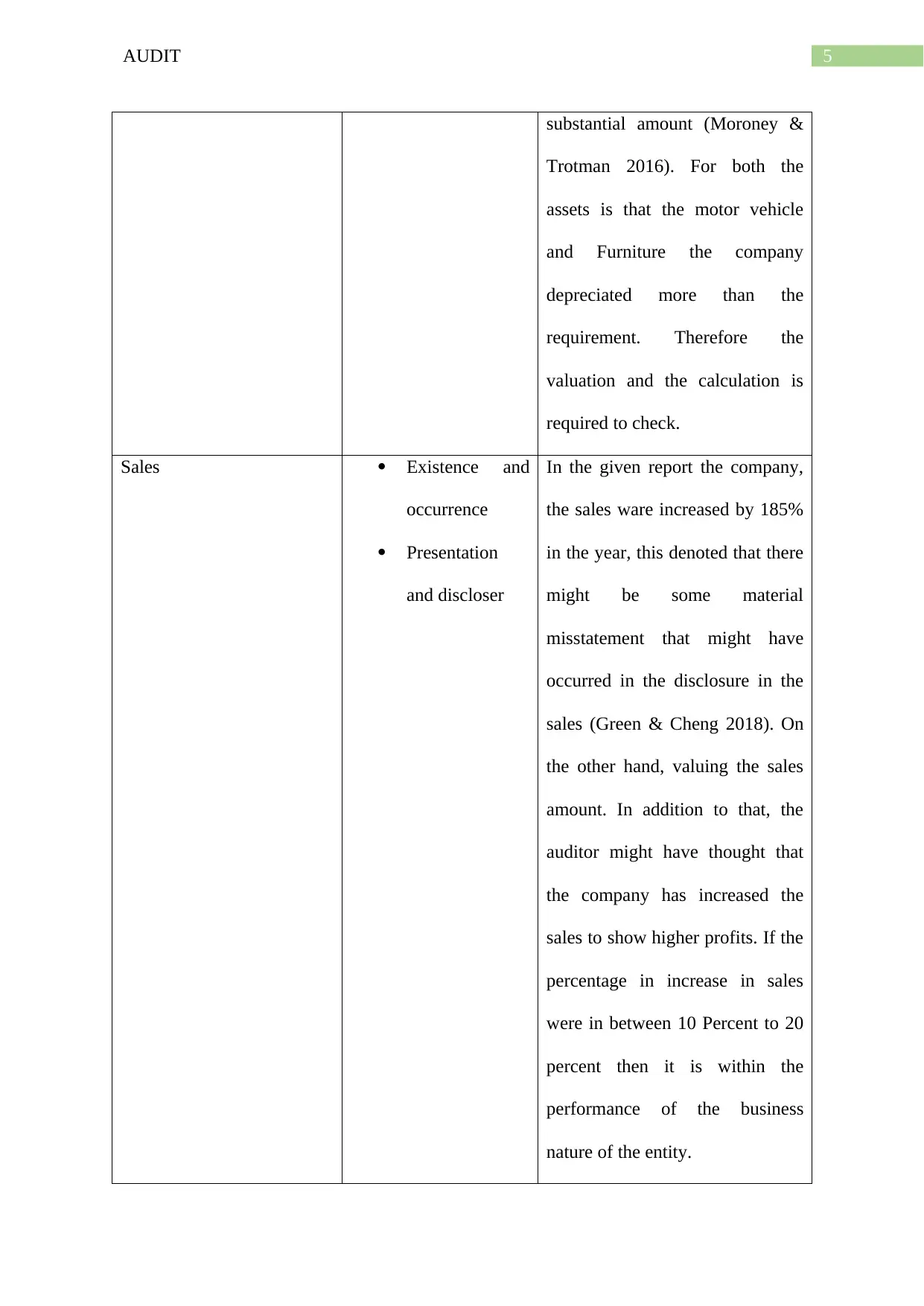
5AUDIT
substantial amount (Moroney &
Trotman 2016). For both the
assets is that the motor vehicle
and Furniture the company
depreciated more than the
requirement. Therefore the
valuation and the calculation is
required to check.
Sales Existence and
occurrence
Presentation
and discloser
In the given report the company,
the sales ware increased by 185%
in the year, this denoted that there
might be some material
misstatement that might have
occurred in the disclosure in the
sales (Green & Cheng 2018). On
the other hand, valuing the sales
amount. In addition to that, the
auditor might have thought that
the company has increased the
sales to show higher profits. If the
percentage in increase in sales
were in between 10 Percent to 20
percent then it is within the
performance of the business
nature of the entity.
substantial amount (Moroney &
Trotman 2016). For both the
assets is that the motor vehicle
and Furniture the company
depreciated more than the
requirement. Therefore the
valuation and the calculation is
required to check.
Sales Existence and
occurrence
Presentation
and discloser
In the given report the company,
the sales ware increased by 185%
in the year, this denoted that there
might be some material
misstatement that might have
occurred in the disclosure in the
sales (Green & Cheng 2018). On
the other hand, valuing the sales
amount. In addition to that, the
auditor might have thought that
the company has increased the
sales to show higher profits. If the
percentage in increase in sales
were in between 10 Percent to 20
percent then it is within the
performance of the business
nature of the entity.
⊘ This is a preview!⊘
Do you want full access?
Subscribe today to unlock all pages.

Trusted by 1+ million students worldwide
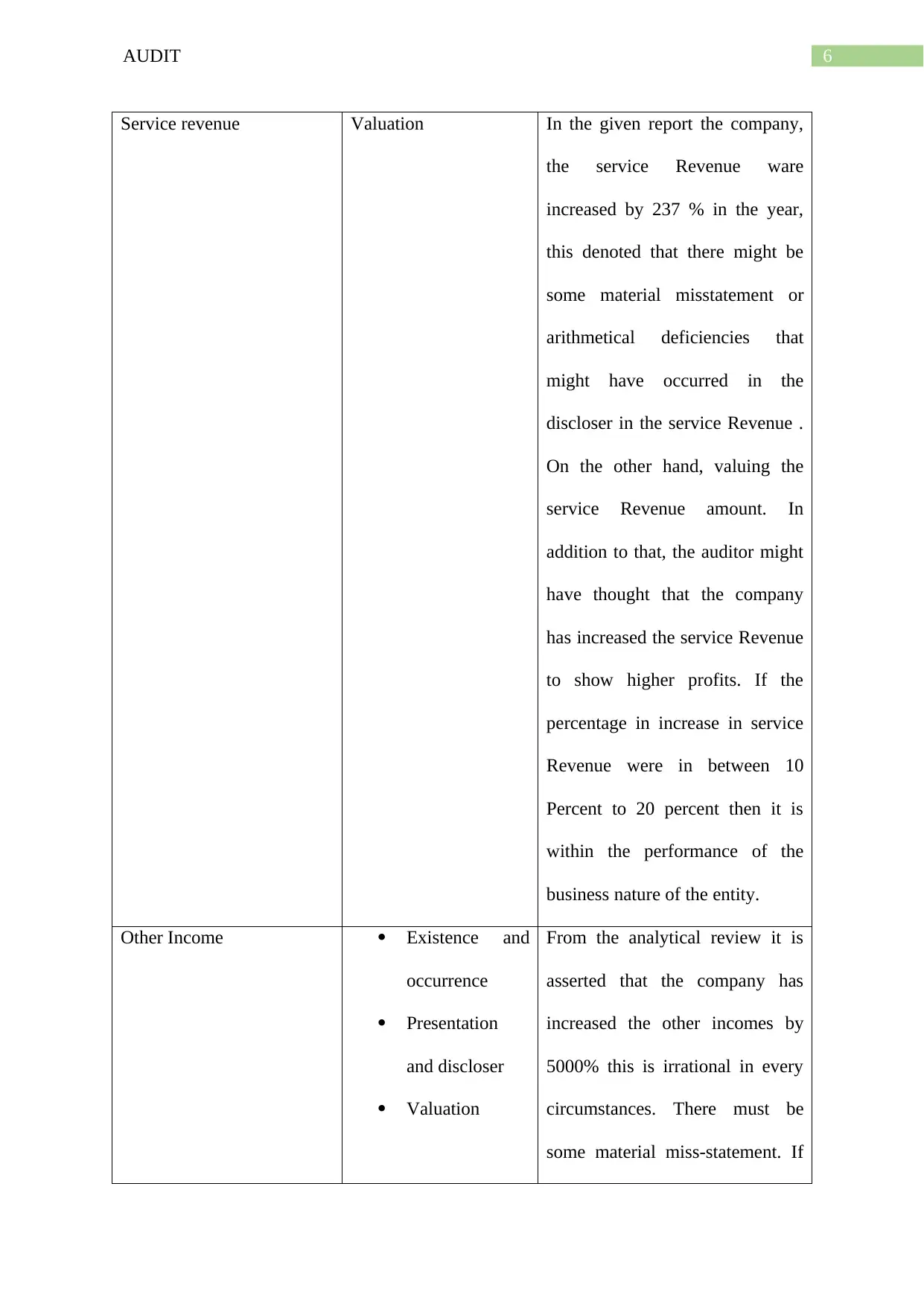
6AUDIT
Service revenue Valuation In the given report the company,
the service Revenue ware
increased by 237 % in the year,
this denoted that there might be
some material misstatement or
arithmetical deficiencies that
might have occurred in the
discloser in the service Revenue .
On the other hand, valuing the
service Revenue amount. In
addition to that, the auditor might
have thought that the company
has increased the service Revenue
to show higher profits. If the
percentage in increase in service
Revenue were in between 10
Percent to 20 percent then it is
within the performance of the
business nature of the entity.
Other Income Existence and
occurrence
Presentation
and discloser
Valuation
From the analytical review it is
asserted that the company has
increased the other incomes by
5000% this is irrational in every
circumstances. There must be
some material miss-statement. If
Service revenue Valuation In the given report the company,
the service Revenue ware
increased by 237 % in the year,
this denoted that there might be
some material misstatement or
arithmetical deficiencies that
might have occurred in the
discloser in the service Revenue .
On the other hand, valuing the
service Revenue amount. In
addition to that, the auditor might
have thought that the company
has increased the service Revenue
to show higher profits. If the
percentage in increase in service
Revenue were in between 10
Percent to 20 percent then it is
within the performance of the
business nature of the entity.
Other Income Existence and
occurrence
Presentation
and discloser
Valuation
From the analytical review it is
asserted that the company has
increased the other incomes by
5000% this is irrational in every
circumstances. There must be
some material miss-statement. If
Paraphrase This Document
Need a fresh take? Get an instant paraphrase of this document with our AI Paraphraser
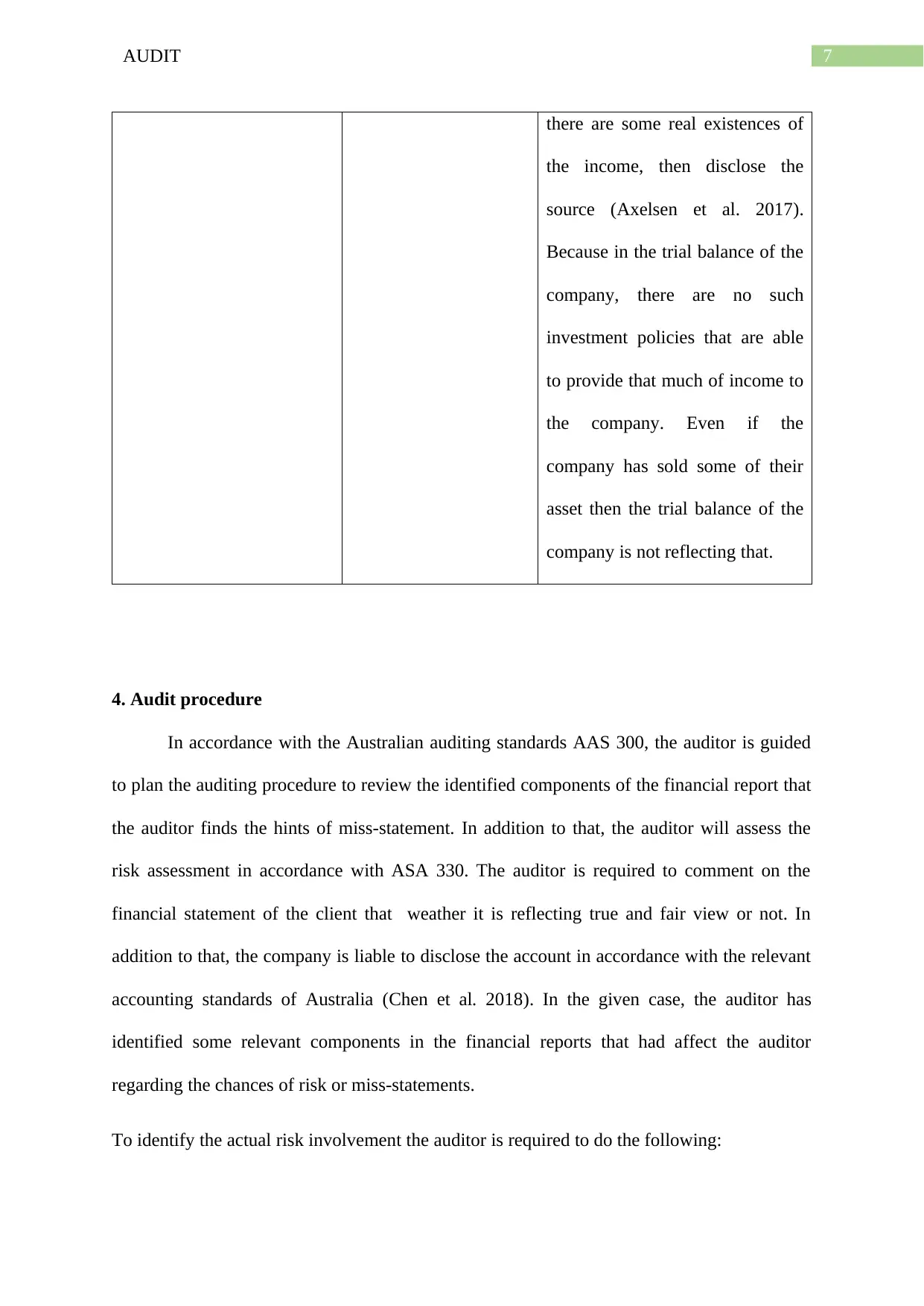
7AUDIT
there are some real existences of
the income, then disclose the
source (Axelsen et al. 2017).
Because in the trial balance of the
company, there are no such
investment policies that are able
to provide that much of income to
the company. Even if the
company has sold some of their
asset then the trial balance of the
company is not reflecting that.
4. Audit procedure
In accordance with the Australian auditing standards AAS 300, the auditor is guided
to plan the auditing procedure to review the identified components of the financial report that
the auditor finds the hints of miss-statement. In addition to that, the auditor will assess the
risk assessment in accordance with ASA 330. The auditor is required to comment on the
financial statement of the client that weather it is reflecting true and fair view or not. In
addition to that, the company is liable to disclose the account in accordance with the relevant
accounting standards of Australia (Chen et al. 2018). In the given case, the auditor has
identified some relevant components in the financial reports that had affect the auditor
regarding the chances of risk or miss-statements.
To identify the actual risk involvement the auditor is required to do the following:
there are some real existences of
the income, then disclose the
source (Axelsen et al. 2017).
Because in the trial balance of the
company, there are no such
investment policies that are able
to provide that much of income to
the company. Even if the
company has sold some of their
asset then the trial balance of the
company is not reflecting that.
4. Audit procedure
In accordance with the Australian auditing standards AAS 300, the auditor is guided
to plan the auditing procedure to review the identified components of the financial report that
the auditor finds the hints of miss-statement. In addition to that, the auditor will assess the
risk assessment in accordance with ASA 330. The auditor is required to comment on the
financial statement of the client that weather it is reflecting true and fair view or not. In
addition to that, the company is liable to disclose the account in accordance with the relevant
accounting standards of Australia (Chen et al. 2018). In the given case, the auditor has
identified some relevant components in the financial reports that had affect the auditor
regarding the chances of risk or miss-statements.
To identify the actual risk involvement the auditor is required to do the following:
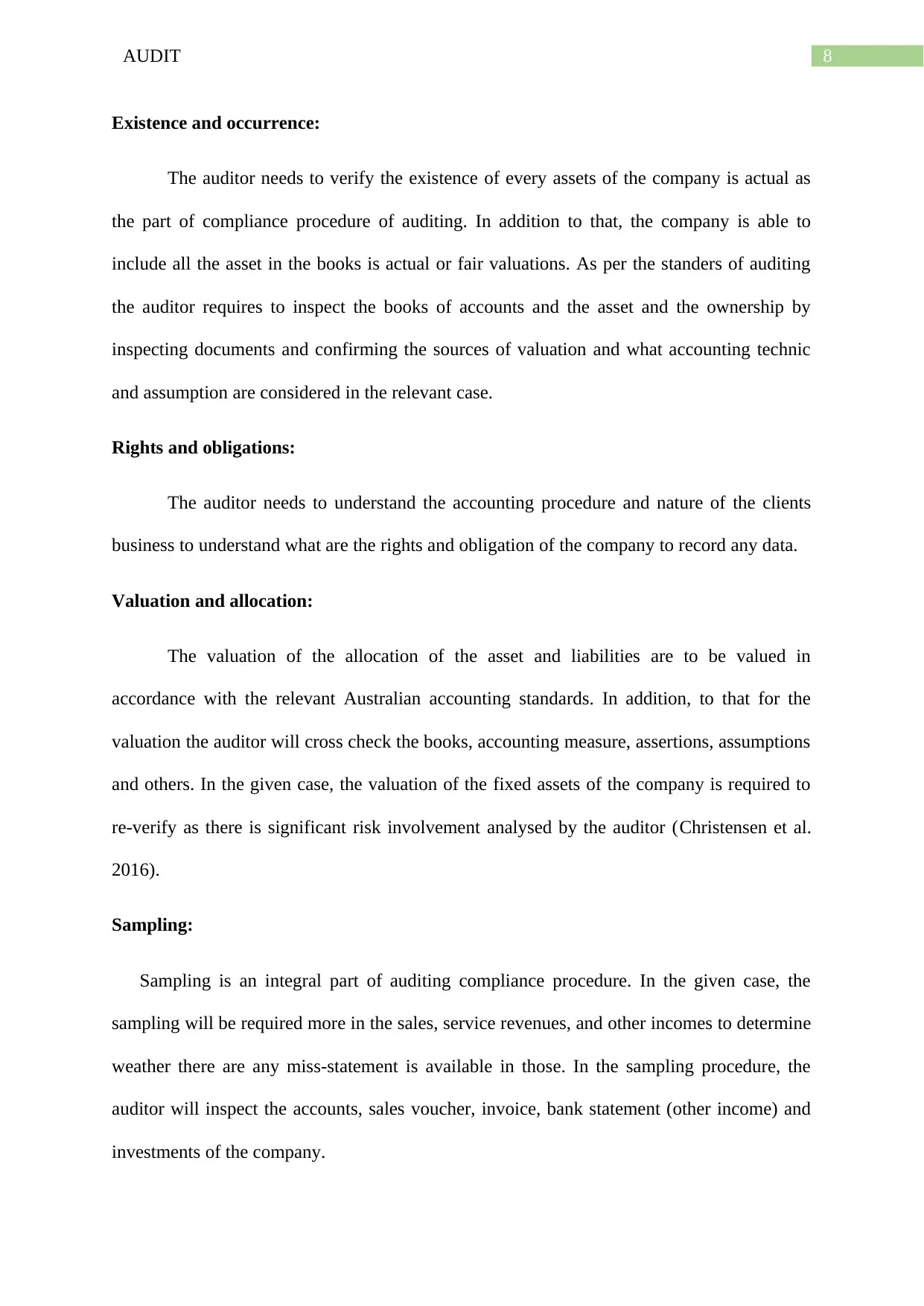
8AUDIT
Existence and occurrence:
The auditor needs to verify the existence of every assets of the company is actual as
the part of compliance procedure of auditing. In addition to that, the company is able to
include all the asset in the books is actual or fair valuations. As per the standers of auditing
the auditor requires to inspect the books of accounts and the asset and the ownership by
inspecting documents and confirming the sources of valuation and what accounting technic
and assumption are considered in the relevant case.
Rights and obligations:
The auditor needs to understand the accounting procedure and nature of the clients
business to understand what are the rights and obligation of the company to record any data.
Valuation and allocation:
The valuation of the allocation of the asset and liabilities are to be valued in
accordance with the relevant Australian accounting standards. In addition, to that for the
valuation the auditor will cross check the books, accounting measure, assertions, assumptions
and others. In the given case, the valuation of the fixed assets of the company is required to
re-verify as there is significant risk involvement analysed by the auditor (Christensen et al.
2016).
Sampling:
Sampling is an integral part of auditing compliance procedure. In the given case, the
sampling will be required more in the sales, service revenues, and other incomes to determine
weather there are any miss-statement is available in those. In the sampling procedure, the
auditor will inspect the accounts, sales voucher, invoice, bank statement (other income) and
investments of the company.
Existence and occurrence:
The auditor needs to verify the existence of every assets of the company is actual as
the part of compliance procedure of auditing. In addition to that, the company is able to
include all the asset in the books is actual or fair valuations. As per the standers of auditing
the auditor requires to inspect the books of accounts and the asset and the ownership by
inspecting documents and confirming the sources of valuation and what accounting technic
and assumption are considered in the relevant case.
Rights and obligations:
The auditor needs to understand the accounting procedure and nature of the clients
business to understand what are the rights and obligation of the company to record any data.
Valuation and allocation:
The valuation of the allocation of the asset and liabilities are to be valued in
accordance with the relevant Australian accounting standards. In addition, to that for the
valuation the auditor will cross check the books, accounting measure, assertions, assumptions
and others. In the given case, the valuation of the fixed assets of the company is required to
re-verify as there is significant risk involvement analysed by the auditor (Christensen et al.
2016).
Sampling:
Sampling is an integral part of auditing compliance procedure. In the given case, the
sampling will be required more in the sales, service revenues, and other incomes to determine
weather there are any miss-statement is available in those. In the sampling procedure, the
auditor will inspect the accounts, sales voucher, invoice, bank statement (other income) and
investments of the company.
⊘ This is a preview!⊘
Do you want full access?
Subscribe today to unlock all pages.

Trusted by 1+ million students worldwide
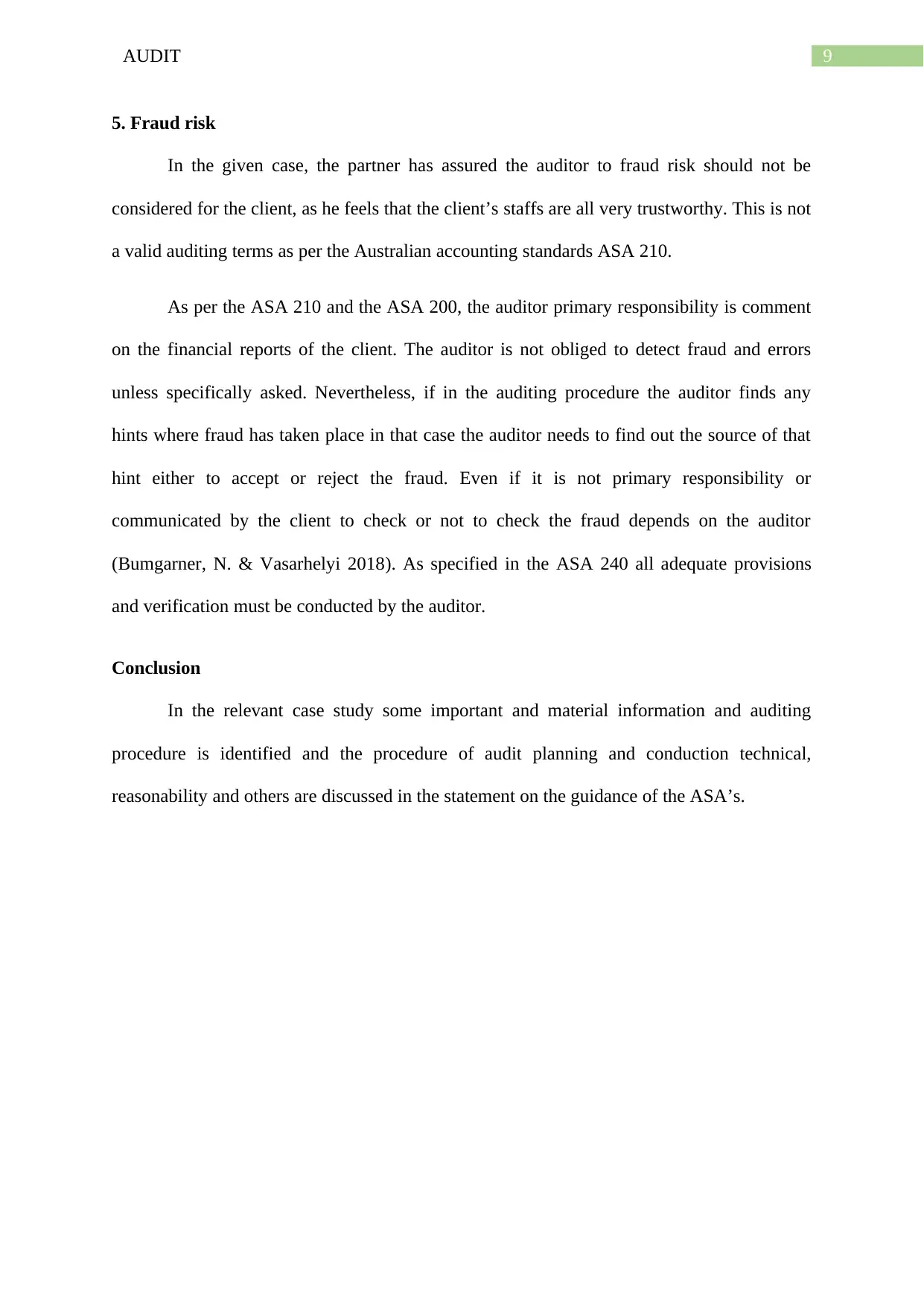
9AUDIT
5. Fraud risk
In the given case, the partner has assured the auditor to fraud risk should not be
considered for the client, as he feels that the client’s staffs are all very trustworthy. This is not
a valid auditing terms as per the Australian accounting standards ASA 210.
As per the ASA 210 and the ASA 200, the auditor primary responsibility is comment
on the financial reports of the client. The auditor is not obliged to detect fraud and errors
unless specifically asked. Nevertheless, if in the auditing procedure the auditor finds any
hints where fraud has taken place in that case the auditor needs to find out the source of that
hint either to accept or reject the fraud. Even if it is not primary responsibility or
communicated by the client to check or not to check the fraud depends on the auditor
(Bumgarner, N. & Vasarhelyi 2018). As specified in the ASA 240 all adequate provisions
and verification must be conducted by the auditor.
Conclusion
In the relevant case study some important and material information and auditing
procedure is identified and the procedure of audit planning and conduction technical,
reasonability and others are discussed in the statement on the guidance of the ASA’s.
5. Fraud risk
In the given case, the partner has assured the auditor to fraud risk should not be
considered for the client, as he feels that the client’s staffs are all very trustworthy. This is not
a valid auditing terms as per the Australian accounting standards ASA 210.
As per the ASA 210 and the ASA 200, the auditor primary responsibility is comment
on the financial reports of the client. The auditor is not obliged to detect fraud and errors
unless specifically asked. Nevertheless, if in the auditing procedure the auditor finds any
hints where fraud has taken place in that case the auditor needs to find out the source of that
hint either to accept or reject the fraud. Even if it is not primary responsibility or
communicated by the client to check or not to check the fraud depends on the auditor
(Bumgarner, N. & Vasarhelyi 2018). As specified in the ASA 240 all adequate provisions
and verification must be conducted by the auditor.
Conclusion
In the relevant case study some important and material information and auditing
procedure is identified and the procedure of audit planning and conduction technical,
reasonability and others are discussed in the statement on the guidance of the ASA’s.
Paraphrase This Document
Need a fresh take? Get an instant paraphrase of this document with our AI Paraphraser
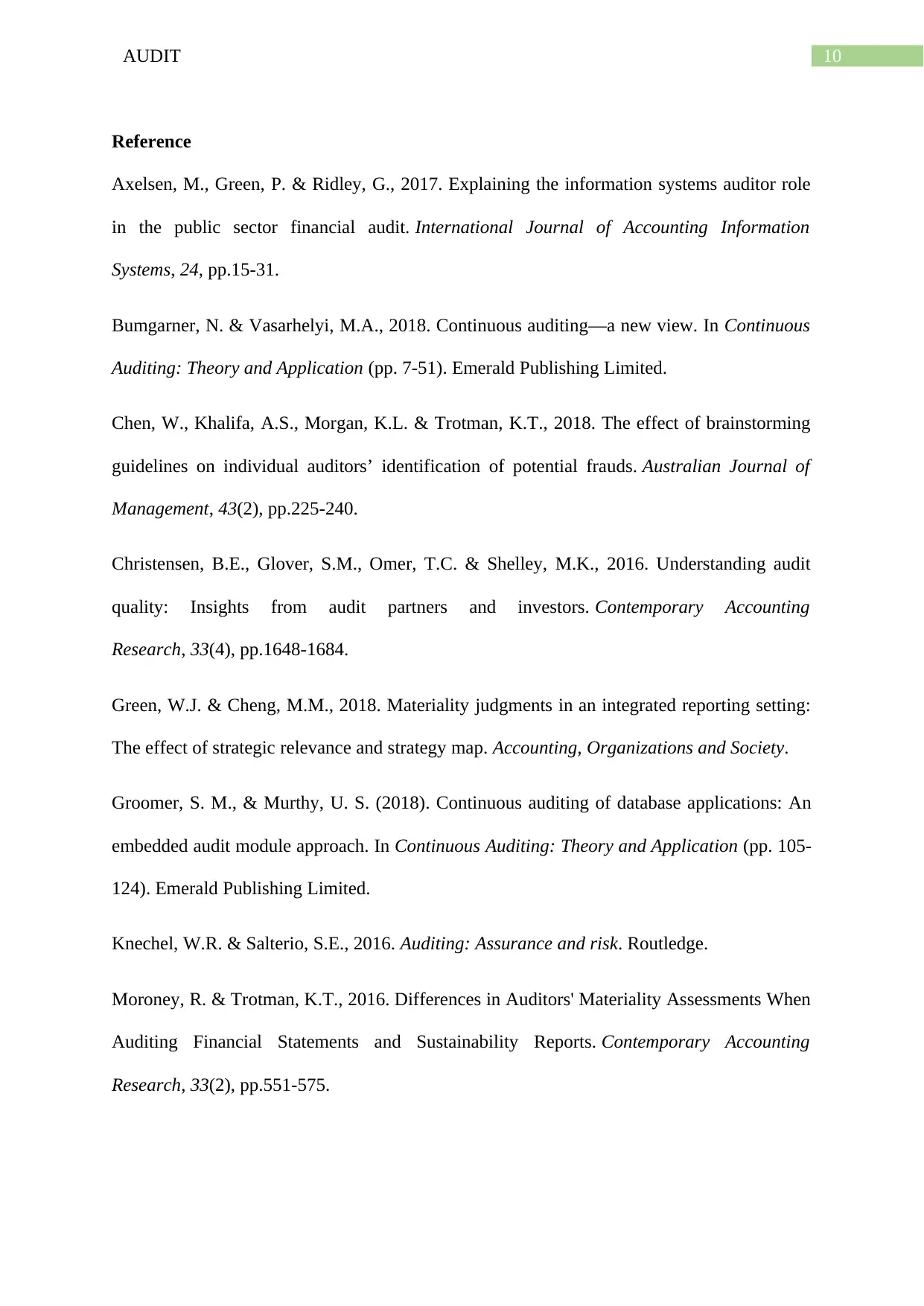
10AUDIT
Reference
Axelsen, M., Green, P. & Ridley, G., 2017. Explaining the information systems auditor role
in the public sector financial audit. International Journal of Accounting Information
Systems, 24, pp.15-31.
Bumgarner, N. & Vasarhelyi, M.A., 2018. Continuous auditing—a new view. In Continuous
Auditing: Theory and Application (pp. 7-51). Emerald Publishing Limited.
Chen, W., Khalifa, A.S., Morgan, K.L. & Trotman, K.T., 2018. The effect of brainstorming
guidelines on individual auditors’ identification of potential frauds. Australian Journal of
Management, 43(2), pp.225-240.
Christensen, B.E., Glover, S.M., Omer, T.C. & Shelley, M.K., 2016. Understanding audit
quality: Insights from audit partners and investors. Contemporary Accounting
Research, 33(4), pp.1648-1684.
Green, W.J. & Cheng, M.M., 2018. Materiality judgments in an integrated reporting setting:
The effect of strategic relevance and strategy map. Accounting, Organizations and Society.
Groomer, S. M., & Murthy, U. S. (2018). Continuous auditing of database applications: An
embedded audit module approach. In Continuous Auditing: Theory and Application (pp. 105-
124). Emerald Publishing Limited.
Knechel, W.R. & Salterio, S.E., 2016. Auditing: Assurance and risk. Routledge.
Moroney, R. & Trotman, K.T., 2016. Differences in Auditors' Materiality Assessments When
Auditing Financial Statements and Sustainability Reports. Contemporary Accounting
Research, 33(2), pp.551-575.
Reference
Axelsen, M., Green, P. & Ridley, G., 2017. Explaining the information systems auditor role
in the public sector financial audit. International Journal of Accounting Information
Systems, 24, pp.15-31.
Bumgarner, N. & Vasarhelyi, M.A., 2018. Continuous auditing—a new view. In Continuous
Auditing: Theory and Application (pp. 7-51). Emerald Publishing Limited.
Chen, W., Khalifa, A.S., Morgan, K.L. & Trotman, K.T., 2018. The effect of brainstorming
guidelines on individual auditors’ identification of potential frauds. Australian Journal of
Management, 43(2), pp.225-240.
Christensen, B.E., Glover, S.M., Omer, T.C. & Shelley, M.K., 2016. Understanding audit
quality: Insights from audit partners and investors. Contemporary Accounting
Research, 33(4), pp.1648-1684.
Green, W.J. & Cheng, M.M., 2018. Materiality judgments in an integrated reporting setting:
The effect of strategic relevance and strategy map. Accounting, Organizations and Society.
Groomer, S. M., & Murthy, U. S. (2018). Continuous auditing of database applications: An
embedded audit module approach. In Continuous Auditing: Theory and Application (pp. 105-
124). Emerald Publishing Limited.
Knechel, W.R. & Salterio, S.E., 2016. Auditing: Assurance and risk. Routledge.
Moroney, R. & Trotman, K.T., 2016. Differences in Auditors' Materiality Assessments When
Auditing Financial Statements and Sustainability Reports. Contemporary Accounting
Research, 33(2), pp.551-575.

11AUDIT
⊘ This is a preview!⊘
Do you want full access?
Subscribe today to unlock all pages.

Trusted by 1+ million students worldwide
1 out of 12
Related Documents
Your All-in-One AI-Powered Toolkit for Academic Success.
+13062052269
info@desklib.com
Available 24*7 on WhatsApp / Email
![[object Object]](/_next/static/media/star-bottom.7253800d.svg)
Unlock your academic potential
Copyright © 2020–2025 A2Z Services. All Rights Reserved. Developed and managed by ZUCOL.





